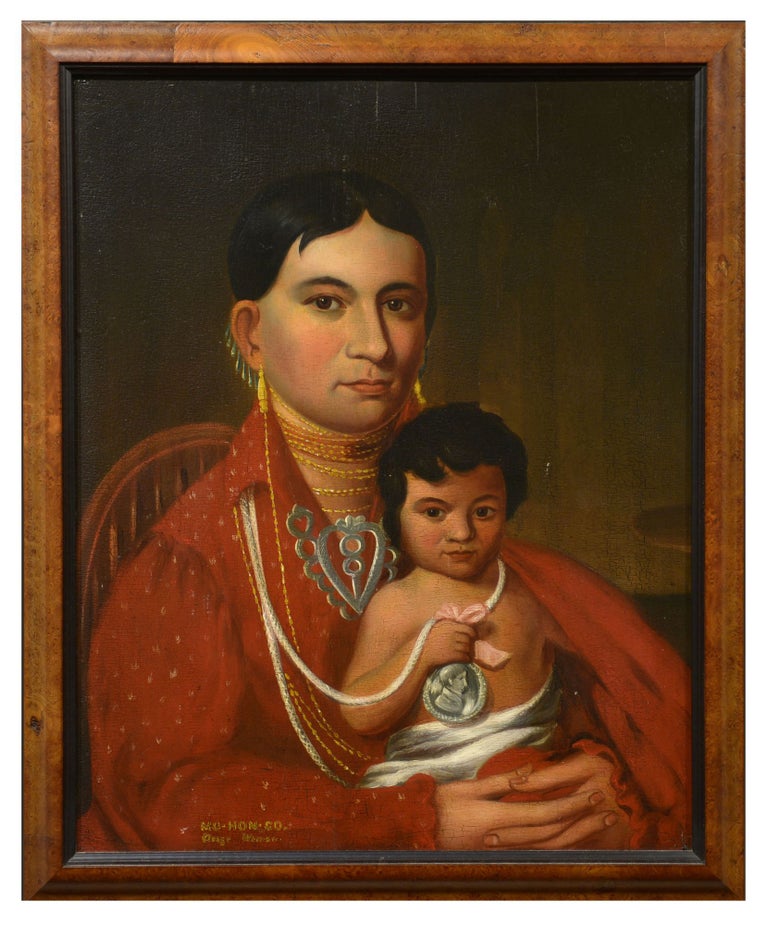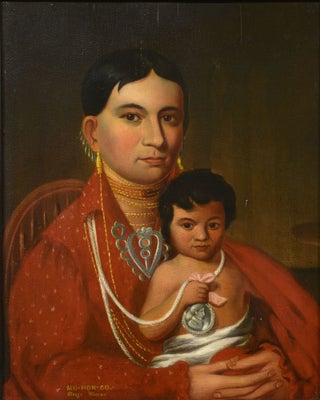Mo-Hon-Go. Osage Woman.
Circa 1860. Oil on panel, 17” x 13.75”. A rare oil portrait after Charles Bird King depicting Mohongo, a young Osage woman who was effectively kidnapped to perform in a wild west show in Europe and then abandoned there. She is shown here with her child, who was born during this time. Mohongo, or Sacred Sun, was one of a group of six Osage who were deceived and taken to Europe in 1827 by one David Delauney, a French-born con-man, who passed himself off as a representative of the U.S. Government intent on bringing them to Washington, D.C. Instead, Delauney took them to France to perform in his Wild West Show. The details of what followed vary across accounts, but the consensus seems to be that while the group was initially well-received—meeting dignitaries, attending the opera, and appearing before King Charles X—their popularity eventually waned. Either because he sought profit elsewhere or was jailed for his debts, Delauney left Mohongo and her companions to their own devices in Paris. At some time during this ordeal, Mohongo gave birth: some accounts report that she had twin girls, one of whom was adopted by a wealthy Belgian woman, others that she had only a single child, born during or immediately after her return to the U.S. In any case, after about two years of itinerancy and near-starvation in Europe, Mohongo and her companions again attracted the attention of the press, and, with it, the sympathy of “America’s favorite Frenchman,” the Marquis de Lafayette, who financed their return to the U.S. in April 1830 (Clark). Smallpox struck on the voyage, killing at least one of the party (possibly Mohongo’s husband). Some time after landing in Virginia, where she again had no means of supporting herself, Mohongo was summoned to the capitol by Thomas McKenney, the first Superintendent of Indian Affairs. In Washington D.C. she received a peace medal from President Andrew Jackson. She was then able to return to the Osage Nation, which in the same year had been confined by Jackson’s Indian Removal Act to land in present-day Oklahoma. In the painting offered here, Mohongo is pictured from the waist up, sitting in a bow-back Windsor chair, wearing a red dress (speckled with white florets), earrings, several necklaces, and the peace medal that President Jackson awarded her. Sitting on her lap, her child holds up the medal. A portion of an oval tabletop is visible on the right side of the painting. While this portrait may have been modeled on the original, done by Charles Bird King during Mohongo’s visit to Washington D.C., it is more likely based on the lithograph after King that appeared in History of the Indian Tribes of North America (1836–44). The artist has departed from the lithograph in various ways, adding the chair back and table top, altering the color of Mohongo’s necklaces from brown to gold, lightening the skin of the subjects, and making adjustments to the shapes of their faces. Background elements were not included in the lithographs after King’s paintings of Native Americans, and King himself rarely included elements that alluded to European-American material culture, suggesting that the chair and table were introduced by the present artist. Initially commissioned by McKenney, King made 143 portraits of Native Americans between 1822 and 1842, during their visits to the capitol. Most of his original paintings were destroyed in a fire at the Smithsonian in 1865, but McKenney and Hall’s History of the Indian Tribes of North America preserved the images for posterity. Born in Rhode Island, he studied under Edward Savage in New York and then under Benjamin West in London. In 1818 King settled permanently in the capitol, where he became a prominent portrait artist among the nation’s political elite. His Native American portraits provide a trove of information on the “complex visual language” of dress and appearance in many Native American tribes (Pohl). His work has also been criticized as a form of “imperialist nostalgia”—celebrating an ideal of the “noble savage” and “yearning for that which one has indirectly or directly participated in destroying” (Pohl). Mohongo’s story and “the dignity and beauty of her countenance” (McKenney and Hall) made her a particularly captivating figure for romanticized narratives about the ‘culturing’ and ‘elevating’ effects of Euro-American civilization upon Native Americans, and therefore rendered her particularly appealing to white audiences. (In 1939, for instance, a Mohongo doll with a heavily mythologized backstory, including her wedding in Notre Dame Cathedral, was shown in the Missouri exhibit at the World’s Fair). This portrait of Mohongo, with its lightened skin tone and non-Native American furnishings, attests to the complexities of Euro-American representation of native peoples and to the widespread fascination with Mohongo’s story. REFERENCES: Clark, Jennifer. “Lithograph of Mohongo, an Osage Woman,” nps.gov; McKenney, Thomas and James Hall. History of the Indian Tribes of North America, with biographical sketches and anecdotes of the principal chiefs, vol. 1 (Philadelphia, 1838), p. 21; Pohl, Frances. “Old World, New World: The Encounter of Cultures on the American Frontier.” Nineteenth Century Art: A Critical History (London, 2007), pp. 188–89; “Portrait Dolls of Missouri’s Famous Women To World Fairs,” The Kansas City Star, 23 April, 1939, p. 50.
Item #7396
Price: $15,000.00



